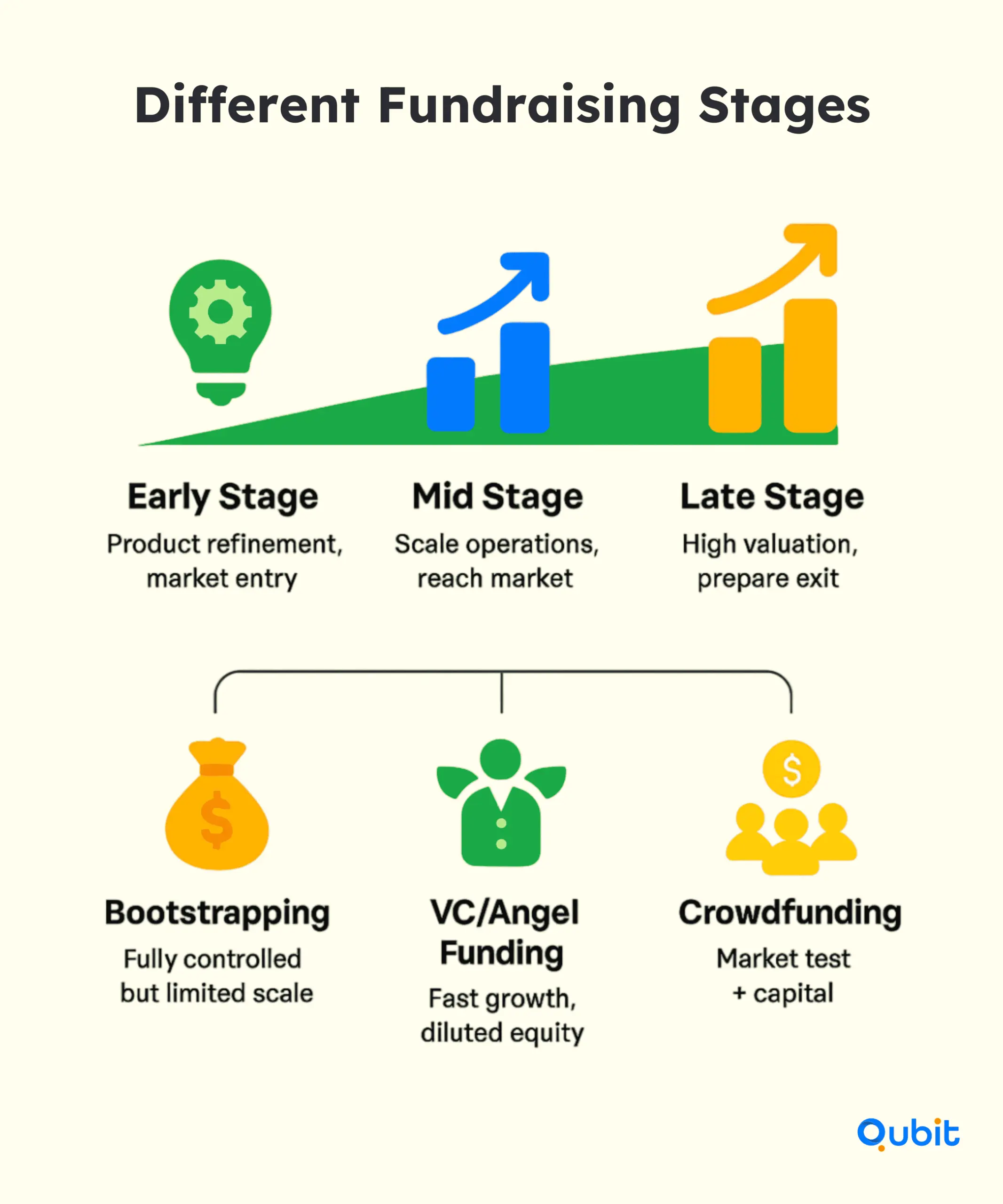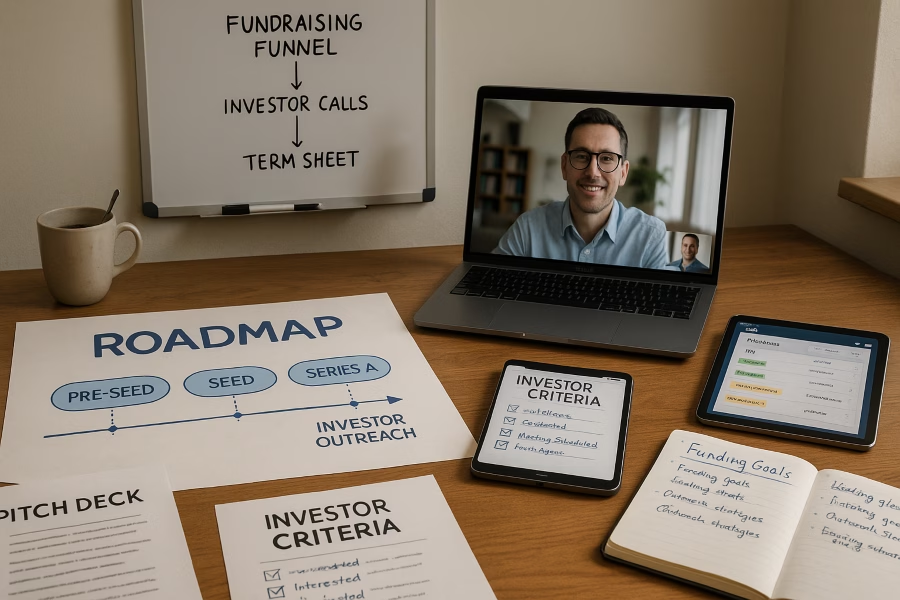Securing funding is a pivotal milestone for startups, often determining their trajectory from concept to market success. Understanding the startup funding stages is essential for founders aiming to attract investors and scale their ventures. This blog outlines a step-by-step roadmap, guiding you through the journey from pre-seed to IPO.
Whether you're refining your pitch or strategizing for investor outreach, actionable insights are key. For example, you encounter practical techniques on how to get startup funding that complement the sequential approach outlined in your fundraising journey.
What to Know Before Raising Capital and Finding Lead Investors
Securing funding for a startup is a pivotal step that requires careful planning and alignment with your company’s vision. Before you raise capital for startup growth, it’s crucial to understand the dynamics of lead investors and their impact on your business.
Lead investors typically contribute the largest portion of funding during a round, but their role extends beyond financial support. They often gain board influence, helping shape strategic decisions and offering valuable guidance. Founders must ensure that the lead investor’s goals align with their startup’s mission to foster a productive partnership.
Additionally, exploring AI-powered fundraising platforms can streamline your pitching and evaluation process, making it easier to identify investors whose interests match your objectives. These platforms utilize automation and intelligent analysis to improve investor targeting and accelerate due diligence.
For early-stage ventures, angel investors also play a significant role. In 2021 alone, angel investors contributed $950M to startups, demonstrating their importance in the fundraising ecosystem.
Breaking Down Startup Funding Stages

Pre-Seed Stage: Laying the Foundation
The pre-seed stage is often the first step in startup funding. At this point, founders typically rely on personal savings, contributions from friends and family, or early angel investors to get their idea off the ground. Funding amounts are generally modest, as the focus is on developing a minimum viable product (MVP) and validating the concept.
This stage is also where crowdfunding platforms can play a pivotal role. For example, the Oculus Crowdfunding Success demonstrated how consumer backing can validate novel tech concepts, proving demand before attracting venture capital.
Seed Stage: Building Traction
The seed stage is where startups begin to attract external investors, such as angel investors and seed funds. Deal sizes at this stage average around $3 million, according to Team SAS. The primary goal is to refine the product, achieve product-market fit, and demonstrate early traction.
Equity dilution starts to become a factor here, with external investors typically owning about 25% of the company. Founders must weigh the trade-offs between raising capital and retaining control.
Series A: Scaling Operations
Series A funding marks the transition from early-stage development to scaling operations. Investors, often venture capital firms, look for startups with proven traction and clear revenue potential. Deal sizes average $11 million, and external investor ownership typically increases slightly to 26%.
A compelling case study is Dropbox, which showcased impressive traction to secure early funding. By emphasizing product-market fit and rapid user adoption, Dropbox attracted top-tier investors, as highlighted in the Dropbox Traction Demonstration.
Series B and Beyond: Accelerating Growth
As startups mature, Series B, C, and later rounds focus on accelerating growth and expanding market share. Deal sizes grow significantly, with Series B averaging $25 million and Series C reaching $36 million. Equity dilution decreases progressively, with external investor ownership dropping to 22% in Series B and 17% in Series C.
Emerging trends, such as interim funding rounds, allow startups to validate milestones progressively. Keeping track of these Funding Trends is essential for founders aiming to stay ahead of evolving round definitions.
IPO: The Final Frontier
The IPO stage represents the culmination of a startup’s funding journey. By going public, companies gain access to substantial capital while providing liquidity to early investors. However, this stage demands rigorous financial metrics and operational transparency.
Startups at various funding stages can also explore collaborative opportunities through platforms like Fusion, an innovation hub from J.P. Morgan that supports startups in scaling their operations.
Strategic Insights for Founders
Understanding deal sizes and equity dynamics is crucial for founders at every stage. For instance, global deal sizes have increased due to expanded venture capital availability and competitive markets, as noted in the Size Trend. Recognizing these shifts can help founders forecast capital infusion needs and plan strategically.
For further actionable insights, explore ways to secure capital for startup, which enriches your understanding of bridging different funding stages while following the roadmap.
How Fundraising Strategy Shapes Your Startup at Every Stage
Fundraising for startups is more than securing capital—it’s a strategic driver that influences growth, scalability, and eventual exit opportunities. From the initial stages of product development to late-stage market expansion, continuous fundraising ensures your startup remains agile and competitive.
Early-stage funding often focuses on building a solid foundation, enabling startups to refine their product and establish a foothold in the market. As the business matures, mid-stage investments fuel operational scaling and market penetration. Late-stage funding, though dilutive, can be transformative when managed effectively. Recent trends highlight a Late-stage funding resurgence, which has significantly boosted Series D and pre-IPO valuations. This resurgence underscores the importance of timing and strategy in maximizing company value during critical growth phases.
Bootstrapping, or using personal funds, is often the first step for many founders. It allows complete control over the business but can limit growth potential if resources are scarce. On the other hand, startup investors, such as angel investors or venture capitalists, provide significant capital in exchange for equity. While this accelerates growth, it may dilute ownership and influence decision-making.
Institutional loans and grants offer another route, providing funds without sacrificing equity. However, these options often come with strict repayment terms or eligibility criteria. Crowdfunding platforms have also gained popularity, enabling startups to raise money from a broad audience. This method not only generates capital but also validates market interest in your product or service.
Combining multiple funding sources can reduce risks and enhance financial flexibility. For example, integrating bootstrapping with external funding minimizes overdependence on a single stream. As highlighted in the trend, using Diversify tactics can mitigate dilution risks and maintain control over your business.
Choosing the right funding mix depends on your startup’s goals, industry, and growth stage. By exploring all available options, you can create a balanced strategy that supports both immediate needs and long-term success.
How to Build a Strong Funding Plan for Your Startup
A strategic funding plan aligns your capital needs with business milestones, ensuring that financial resources are available when they’re most needed. This approach not only supports growth but also minimizes risks associated with underfunding or overfunding.
Steps to Create a Strategic Funding Plan
Define Your Business Milestones
Begin by identifying key milestones, such as product launches, market expansions, or revenue targets. These milestones will serve as benchmarks for determining when and how much funding is required.Estimate Capital Needs
Calculate the financial resources necessary to achieve each milestone. Include operational costs, marketing budgets, and contingency funds to ensure comprehensive planning.Set Timelines and Financial Targets
Establish clear timelines for achieving milestones and corresponding financial goals. This structure helps synchronize funding acquisition with growth objectives.Prepare for Investor Outreach
Develop a compelling pitch that highlights your startup’s potential and aligns with the funding plan. Tools like Kinexys can assist in tracking progress and scenario planning, ensuring your funding strategy remains adaptable.
For a broader perspective on capital acquisition, explore startup fundraising strategies. This resource complements the detailed steps outlined here, offering insights into effective ways to secure funding.
A well-crafted funding plan is the foundation for sustainable scaling, enabling startups to grow confidently while meeting critical milestones.
Startups often face unique challenges when scaling, from securing funding to establishing solid legal and financial frameworks. J.P. Morgan addresses these hurdles with tailored banking solutions designed to empower startups at every stage of growth.
By combining financial expertise with strategic partnerships, J.P. Morgan offers specialized solutions that help startups attract startup investors and scale efficiently. For instance, integrating J.P. Morgan's services with tools like Atlas Docs ensures startups have coherent legal and financial groundwork, setting the stage for sustainable growth.
Whether you're looking to streamline operations or build investor confidence, J.P. Morgan’s innovative approach provides the resources and guidance startups need to thrive in competitive markets.
Startups represent the intersection of ambition and innovation, often characterized by their high growth potential and inherent uncertainty. These emerging companies aim to disrupt industries or create entirely new markets, but their success hinges on securing the right funding at the right time.
Funding for startups typically unfolds in sequential stages, starting with early development rounds such as bootstrapping or seed funding. At this stage, founders often exchange equity for capital to build prototypes or validate their ideas. As the startup grows, larger funding rounds—Series A, B, and beyond—introduce significant investors, often resulting in trend_dilution of equity. These rounds fuel expansion, product scaling, and market penetration.
Understanding the nuances of startup funding stages is essential for founders aiming to balance growth with ownership retention. By strategically planning funding mechanisms, startups can propel their development while maintaining their identity in a competitive landscape.
Find More Resources and Articles to Grow Your Startup
Expanding your knowledge is key to mastering the art of raising capital for your startup. Dive into curated articles and resources that explore the intricacies of fundraising strategies, investor relations, and growth planning. These materials provide actionable insights to help you refine your approach and make informed decisions.
Conclusion
A structured approach to fundraising is essential for startups aiming to achieve sustainable growth. Throughout this blog, we’ve explored actionable strategies and insights that emphasize the importance of a clear funding roadmap. By integrating real-world data and strategic planning, startups can streamline their fundraising efforts and secure investments that align with their long-term goals.
At Qubit Capital, we understand the complexities of the fundraising process and are here to assist you every step of the way. If you're looking to secure the right investment strategies, we at Qubit Capital are ready to help with our Fundraising Assistance service. Let us help you turn your vision into reality.
Key Takeaways
• Understanding your startup’s funding stage is vital for strategic planning.
• Lead investors play a key role in shaping strategy and governance.
• Diverse funding sources offer unique benefits and reduce reliance on one option.
• A robust funding plan aligns milestones with capital needs for sustainable growth.
• Real-world examples highlight the value of targeted outreach and data-driven decisions.
Frequently asked Questions
What are the 4 steps of raising money for a startup?
Typically, the steps include: 1. Preparing a compelling pitch; 2. Identifying and targeting the right investors; 3. Conducting thorough due diligence; 4. Closing the deal successfully.


 Back
Back



